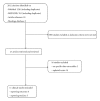Sinonasal malignancies and charged particle radiation treatment: a systematic literature review
- PMID: 22693516
- PMCID: PMC3368195
- DOI: 10.1155/2012/325891
Sinonasal malignancies and charged particle radiation treatment: a systematic literature review
Abstract
Background. Paranasal and nasal cavity malignancies are rare tumors that frequently present at advanced stages. Tumor extension and anatomic complexity pose a challenge for their treatment. Due to their peculiar physical and biological properties particle radiation therapy, i.e. protons and ions can have a role in their management. We performed a systematic literature review to gather clinical evidence about their use to treat sinonasal malignancies. Materials and Methods. We searched the browsers PubMed and Medline as well as specific journals and conference proceedings. Inclusion criteria were: at least 10 patients, English language, reporting outcome and/or toxicity data. Results. We found six studies with data on clinical outcome. Carbon and helium ions were each used in one study, protons in four. Toxicity was specifically described in five studies. One reported acute toxicity of carbon ions, one dealt with brain toxicity from both carbon ions and protons. Three papers reported on visual toxicity: one from carbon ions, one from protons and one from both. Specific data were extracted and compared with the most pertinent literature. Conclusion. Particle radiation therapy is in its early phase of development. Promising results achieved so far must be confirmed in further studies.
Figures
References
-
- Muir CS, Nectoux J. Descriptive epidemiology of malignant neoplasms of nose, nasal cavities, middle ear and accessory sinuses. Clinical Otolaryngology and Allied Sciences. 1980;5(3):195–211. - PubMed
-
- Roush GC. Epidemiology of cancer of the nose and paranasal sinuses: current concepts. Head and Neck Surgery. 1979;2(1):3–11. - PubMed
-
- Dulguerov P, Jacobsen MS, Allal AS, et al. Nasal and paranasal sinus carcinoma: are we making progress? A series of 220 patients and a systematic review. Cancer. 2001;92:3012–3029. - PubMed
-
- Grau C, Jakobsen MH, Harbo G, et al. Sino-nasal cancer in Denmark 1982–1991: a nationwide survey. Acta Oncologica. 2001;40(1):19–23. - PubMed
-
- Chang AE, Karnell LH, Menck HR. The National Cancer Data Base report on cutaneous and noncutaneous melanoma. Cancer. 1998;83:1664–1678. - PubMed
LinkOut - more resources
Full Text Sources



